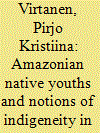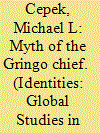|
|
|
Sort Order |
|
|
|
Items / Page
|
|
|
|
|
|
|
| Srl | Item |
| 1 |
ID:
096477


|
|
|
|
|
| Publication |
2010.
|
| Summary/Abstract |
The indigenous presence in urban areas of Amazonia has become more visible as Indian populations have negotiated their own spaces and acted in new contexts previously reserved for the dominant society. This article looks at ways in which today's young Indians in an urban area define and interpret their new cultural and social situations, drawing from research conducted with Apurin , Cashinahua and Manchineri youths in Rio Branco, a city in Acre state, Western Brazil. These young people occupy a variety of "native" and "non-native" habituses and develop their notions of indigeneity within complex social networks as part of their strategy for rupturing the otherness associated with indigeneity. The text contributes to the discussion on the theory of practice and identity politics, as well as embodiment. Young Indians in urban Amazonia constitute their agencies in multiple ways and use various embodiments based in the practices and knowledge of their native groups and those of urban national and global society. The young natives break with the image of Lowland South American Indians as peoples uncontaminated by urban influences and help promote new interactions between native populations in the reserve and the city.
|
|
|
|
|
|
|
|
|
|
|
|
|
|
|
|
| 2 |
ID:
137680


|
|
|
|
|
| Summary/Abstract |
This study evaluates scenarios for the oil production in Peru applying a Hubbert model. Two scenarios for the estimated ultimate recovery (EUR) were proposed: the first, in which low investments in E&P and social and environmental barriers undermine the development of oil resources beyond the limits characterized as 2P; the second, more optimistic, in which current exploratory and production areas in Amazonia and low-explored Offshore-Shelf basins are developed, thus, increasing EUR to 3P reserves plus contingent resources. Findings show that oil production in Peru has not followed a Single-Hubbert pattern, except for the area with more drilling activity and the highest accumulated production in the Northwest coast. Actually, institutional and regulation changes and less-attractive periods for operators due to poor results in oil discoveries explain why a multi-Hubbert approach better depicted the oil production in Peru. Peru has the potential to achieve a second peak of 274 kbpd of crude oil, overcoming the peak of 195 kbpd, reached in 1982. However, most of the remaining production would be located in Amazonia, where social and environmental issues pose critical challenges.
|
|
|
|
|
|
|
|
|
|
|
|
|
|
|
|
| 3 |
ID:
087520


|
|
|
|
|
| Publication |
2009.
|
| Summary/Abstract |
In this article, I investigate the sociocultural grounding and sociopolitical position of Randy Borman, the "gringo chief" of the indigenous Cof n people of Amazonian Ecuador. Born to North American missionary-linguists, Borman grew up in Cof n communities, attended school in urban Ecuador and the United States, and developed into the most important Cof n activist on the global stage. I consider him alongside other ethnically ambiguous leaders of Amazonian political movements, whom anthropologists have described as "messianic" figures. The historians and ethnographers who write about Amazonian messianism debate the relationship between myth and reason in indigenous political action. Using their discussion as a starting point, I propose the concept of "mythical politics," a type of transformative action that concentrates enabling forms of socio-temporal mediation in the shape of individual actors and instantaneous events. I develop my approach through a discussion of the work of Georges Sorel, Georg Luk cs, and Antonio Gramsci, three theorists who debate the role of myth in political mobilization. By applying their insights to the case of Borman, I explore the relationship between myth, mediation, and rationality in Cof n politics and political movements more generally.
|
|
|
|
|
|
|
|
|
|
|
|
|
|
|
|
| 4 |
ID:
170588


|
|
|
|
|
| Summary/Abstract |
The policies and collaborations between governments and civil society that kept forests standing in many parts of Amazonia have come to an end, at least for now.
|
|
|
|
|
|
|
|
|
|
|
|
|
|
|
|
|
|
|
|
|